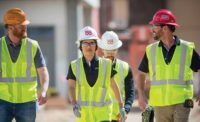National Women in Construction week is being celebrated during early March, with a number of events and outreach happening at WIC chapters across the country. The events, one of them in Denver on March 5, take place as construction activity in the Rocky Mountain region remains at strong levels.
Even while regional employment is beginning to flatten after reaching record highs in early 2014, the need to attract and retain quality talent will always be a key to success in the industry. And women are playing a much bigger role in that.
Anecdotal evidence reflects a trend of more women working in construction, yet demographics suggest that women remain an untapped market for both the supervisory and craft labor pools. Statistics from the U.S. Dept. of Labor show that the percentage of women employed in construction makes up only 9.3% of the overall construction workforce. Yet, women make up 47% of the overall U.S. workforce.
Lisa Reiswig, president of the Denver Chapter of Women in Construction, says that women remain underrepresented in construction. “I do believe that the number of women in the industry has increased in the last couple of decades. I believe that the future for women in the construction industry is very bright,” Reiswig says. But she also believes the industry would see an increase in the overall percentage of women in the industry if there was a more focused effort to market to that demographic.
Anna Fontana, internship and outreach coordinator for the construction management program at Colorado State University in Fort Collins, Colo., who’s also a 2007 graduate of the program, agrees. “I believe there is a lot of opportunity to increase interest and an ultimate path to a career in construction management for women,” she says.
Since CSU has returned to the option of allowing students to choose a minor in construction management, the university is seeing more interest from women. “Oftentimes, we see engineering or design majors who want to make a change to CM after getting exposure to CM classes as part of their minor studies,” Fontana adds.
Forecasts for craft labor training predict a growth curve for women in the industry. Denver’s Emily Griffith Opportunity School’s Construction Careers Now! program, which focuses on improving the labor pool, includes a partnership among the Associated General Contractors of Colorado, the Colorado Contractors Association and the Hispanic Contractors of Colorado. In its first few months of operation, statistics for the program show steady levels of female enrollment and graduation rates for the four-week training. Class ratios are averaging about 20% female to 80% male graduates.
Construction is the number-one industry closing the pay gap between men and women. Perhaps that statistic could be better leveraged to support a recruiting outreach effort to women. On average, a woman working in the construction industry makes 91.3% of what a man in the same position would make. The same comparison for the overall average for women’s wages compared to men’s shows that the statistic falls to 83%. At the bottom end of the scale is the legal industry where on average, women only make 56.7 % compared to men.
Question & Answer
As part of the celebration of WIC week this March, a cross-section of Colorado women in the AEC industry responded to questions about their careers and changing roles. Here are their responses.
Q: How would you describe the current state of the construction industry for women?
Taryn Edwards, senior vice president, Saunders Construction:
“I started in the industry 30 years ago and have seen immense change over that time. One big thing I have noticed is that women are no longer an anomaly on the project site. I also see women becoming mentors to younger women. This way we are supporting each other and growing the base of women in construction and surrounding industries.”
Maja Rosenquist, senior vice president and general manager, Mortenson Denver:
“We have made real progress over the last 23 years that I have been in this industry, but we still have work to do. I had the opportunity to work in Seattle, Minneapolis, Dallas and San Francisco before coming to Denver, and it’s interesting to see that there are more women in some geographies than others.
“I was in San Francisco 15 years ago and worked with a number of women in leadership positions with our trade partners and within our craft; we are just starting to get to this level now in Denver. The jobsite edict has improved immensely over the last 20 years and I do feel the vast majority of people with in our industry are supportive and welcoming of women in construction—now we need to improve the pipeline.”
Lisa Reiswig, president, NAWIC Denver Chapter:
“I feel that the industry currently is lacking the number of women workers (as compared to men), but I do believe that the number of women in the industry has increased in the last couple of decades.
“I believe this is related to the training programs and unions lacking to market toward women to bring them into the industry. It seems that a majority of the women in the construction industry are in admin or management positions, which is great, but we would like to see more women in trade positions as well.”
Denise Burgess, owner and president, Burgess Services:
“Construction has grown both technically and culturally. From a cultural point of view, women in construction was a rarity, especially in the field or in project management.
“I welcome the new generation of construction, which includes young female engineers but also includes men who have been raised by working mothers and who have sisters who are in the workforce. It makes a difference and allows for an inclusive environment on job sites. I periodically get the ‘I thought it was a typo, and I was expecting a Dennis and not a Denise.’”
Jennifer Ray, director of government & community relations, Woodward:
“I work in a male-dominated industry, so shifting to the Lincoln Campus construction portion wasn’t an issue for me. During our 3.5-year project, I had the opportunity to interface with many women at Mortenson and other key trade partners, and it expanded thinking and made for a great team dynamic. I was impressed with the experience and expertise these women brought to the table and the critical roles they played in those challenging and highly respected roles.”
Q: What do you expect for women in the AEC industry in the future?
Taryn Edwards:
“The future will continue to provide immense opportunities to enable women’s growth and be in key leadership roles. The manner in which construction will be done in the future with technology, how projects are contracted such as IPD and P3s, etc. plays in favors of women’s inherent skills.
“I hope to see continued diversity of people in the construction industry for many years to come. Diversity in all aspects brings strength, innovation and growth to a traditionally ridged industry.”
Maja Rosenquist:
“Women are often perceived as having a more collaborative leadership style that focuses on communication and building strong teams. These skills will be a continued strength for the future of our industry, both in creating great culture within an organization and as well as client development. Progressive companies are absolutely looking for different points of views and experience to influence outcomes. There is absolutely huge opportunity for women in our business.”
Lisa Reiswig:
“With more young women becoming interested in the industry at a younger age and working through college to pursue a degree in the construction industry (or one they can use in the industry), I believe that women will have a stronger presence in the next couple of decades.”
Denise Burgess:
“I expect the industry to keep growing and progressing. The role of GC/CM and subcontractor is continually changing. Our two roles are now more interdependent than ever. The owner expects us to be a team, and the project definitely requires it.
“Women bring those listening skills and inclusive behavior to the table. This is not a stereotype but an asset ‘muscle’ that we use. The more everyone understands that the industry is changing and women are part of that change, the better construction will be as a whole.”




